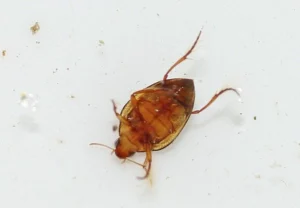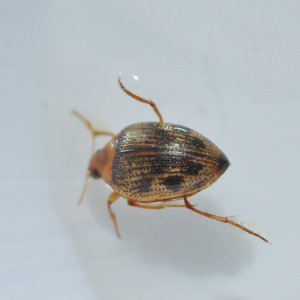Howdy, BugFans,
May is National Wetlands Month, and the BugLady is celebrating by re-posting episodes about aquatic critters from deep in the BOTW archives (this one is from 2012, with some new words added).
The BugLady heard an interesting interview on the radio a while back in which the guest said that non-scientists are intimidated by the feeling that they must know the exact names of the plants and animals on their landscapes in order to discuss them, and that the belief that those names belong only to scientists causes people to become estranged from the natural world. Yes and no. While it is true that each organism has a scientific name that belongs to it alone and is universally recognized, the amazing world of common names is up for grabs. Common names are the names bestowed by people, often regionally, who experience an organism where the rubber meets the road. The more abundant or beloved or notorious or scary an organism is, the more common names it’s likely to have collected.
So – what to name a small, yellowish, spotted, aquatic beetle that scrambles through the water, head down, in perpetual motion? That, rather than “rowing” its legs in synchrony like a water boatman, “dog-paddles,” moving its legs alternately, appearing to crawl through the water. OK – Crawling water beetle it is.
There are almost 70 species of Crawling Water Beetles (family Haliplidae) in North America, divided up among four genera (this beetle belongs to the most common genus, Haliplus) (probably) – Haliplus, because the other common genus, Peltodytes, has two spots on the thorax, just north of the elytra (wing covers). Identification to species can be tricky and gets very up close and personal. A Crawling water beetle that’s ¼” long is a big Crawling water beetle. Haliplids favor still, shallow water and the pool areas of streams and rivers everywhere (except Antarctica) (they favor temperate regions), and the BugLady read about an endangered Irish species that lives in tidal salt marshes. Three of Wisconsin’s Crawling water beetle species are listed as rare.
Crawling water beetles that live in ponds and lake edges can be found scrambling through the water column or feeding in mats of aquatic plants, especially algae. Where there is a current, look for them in crevices between rocks. Unlike many of their aquatic brethren, Crawling water beetles are bulky (one source said “barrel-shaped”), mediocre swimmers that are not streamlined, and other than some long hairs on their back four feet, their legs are not adapted for swimming (they are weak fliers, too, on wings that are rolled – not folded – under the elytra when not in use).

Their two hind legs are modified – but they’re modified for breathing. The sections at the base of each hind leg (closest to the body) are greatly flattened to form “coxal plates” that meet under the beetle. Together, the coxal plates cover part of the thorax and abdomen and create a second space to carry oxygen. When it needs oxygen, a Crawling water beetle backs up to the surface film, takes in air, and stores it in an area on its back, above its abdomen and beneath its elytra. A reserve supply is cached between the coxal plates and the lower surface of the abdomen, and it is in communion with the air under the elytra. Insects take in air through breathing pores called spiracles, and there are spiracles located under the coxal plates.
A bubble of air peeking out from under the elytra helps Crawling water beetle float to the water’s surface (a Crawling water beetle that’s low on air loses buoyancy and must clamber back up the vegetation). The long, skinny Crawling water beetle larvae simply breathe through their skin and don’t develop spiracles until they are almost ready to pupate.
There’s a lot of variation in Crawling water beetle larvae across the various genera.
Crawling water beetles lay their eggs on submerged aquatic plants, especially filamentous algae. Some excavate small holes in the plant tissue and lay their eggs inside. The short-legged, hook-footed larvae creep about on algae mats, where they are well-camouflaged, playing dead when alarmed (alarmed adults make for the bottom of the pond and cling to plant stems there), feeding on their algal substrate with mouthparts that are adapted for grabbing algae, piercing its walls, and sucking out its juices. Larvae that are too tiny to puncture the tough cell walls feed on the fungi and bacteria on the algae’s exterior. Adults continue to feed on algae, but they add protein to their diet in the form of tiny invertebrates like worms, daphnia, and midge eggs. They are eaten by fish, salamanders, and larger aquatic insects.
Crawling water beetle larvae pupate on the shore, in a cell they prepare under a rock or log near the water’s edge. Their new-found spiracles allow them to breathe out of water. Some species spend the winter as pupae; others emerge to spend the winter in the water as adults.
Adults can be found in the water all year round, moving slowly under the ice in winter and congregating in deep spots where the photosynthesis of aquatic plants provides oxygen. Larvae are seen in spring.
Haliplids are among the many shy, retiring insects who live their lives off our radar, simply because their lives don’t impact ours in any economic way (“man is the measure of all things,” said the BugLady’s high school English teacher).
The BugLady photographs aquatic invertebrates as they swim around in a white, plastic spoon. Crawling water beetles do not stop and pose. View some better pictures.
Go outside. Name stuff!
The BugLady
